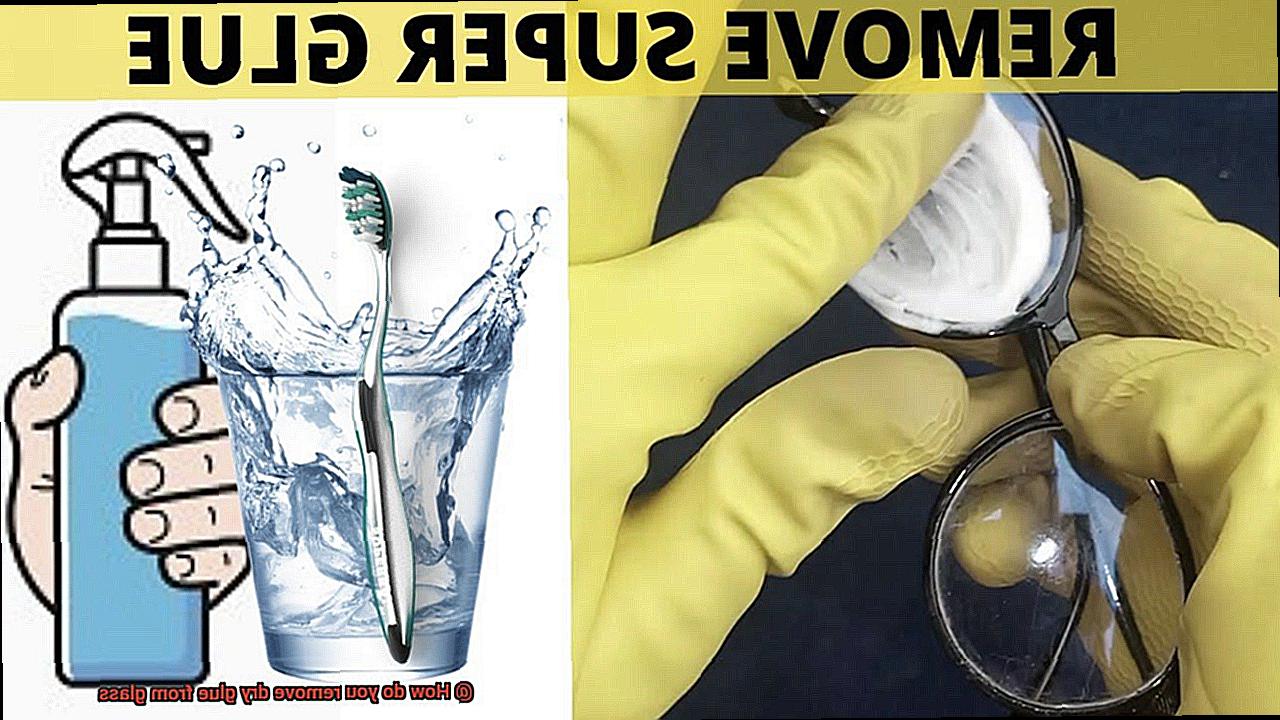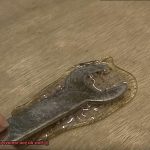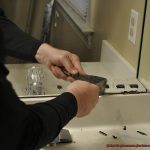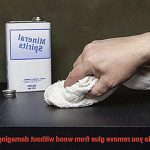You finally manage to peel off that annoying sticker from your favorite glass item, only to be left with a sticky mess of dry glue. Ugh. But don’t fret, my friend, because we’re here to save the day and rescue your glass from that clingy adhesive.
Whether it’s a fancy mason jar, a cherished picture frame, or a beloved vase, getting rid of those stubborn glue marks can feel like an impossible mission. But fear not. We’ve got your back with a bunch of tried-and-true techniques that will have your glass looking squeaky clean in no time.
In this super-duper guide, we’ll dive into different methods for tackling different types of glue so you’ll be armed with all the know-how to banish every last trace of stickiness from your precious glass treasures. So grab your supplies and get ready to say adios to that pesky glue residue that’s been driving you bonkers.
Method 1: Using warm water and dish soap to soften and remove the glue.
Contents
- 1 Method 1: Using warm water and dish soap to soften and remove the glue.
- 2 Method 2: Using rubbing alcohol or acetone as solvents to dissolve the glue.
- 3 Method 3: Utilizing vinegar or lemon juice’s acidic properties to break down the glue.
- 4 Method 4: Applying heat with a hairdryer or heat gun to soften and scrape off the glue.
- 5 Method 5: Commercial adhesive removers designed specifically for glass surfaces.
- 6 Precautions: Tips on how to be cautious when removing dry glue from glass to prevent damage.
- 7 Troubleshooting: What to do if none of the methods work or if there are stubborn residue spots left behind.
- 8 Prevention: Suggestions on how to prevent future instances of dry glue on glass surfaces.
- 9 Conclusion
Whether you’re dealing with the aftermath of a crafting mishap or struggling to remove an obstinate sticker, getting rid of glue from glass can be a daunting task. Fortunately, there’s a straightforward and highly effective method that utilizes warm water and dish soap to effortlessly soften and remove glue. In this comprehensive guide, we will walk you through the step-by-step process of using this remarkable technique to restore your glass surfaces to their former glory.
Step 1: Gather the materials
To get started, collect all the necessary materials. You’ll need a basin or container large enough to accommodate the glass object, warm water, dish soap, a soft cloth or sponge, and a plastic scraper or credit card for delicately scraping off the softened glue.
Step 2: Prepare the warm water and dish soap mixture
Fill the basin or container with comfortably warm water. It’s crucial to strike the perfect balance between warmth and heat; avoid using boiling hot water to prevent damage. Next, add a few drops of dish soap to the water, giving it a gentle stir. The dish soap acts as a powerful adhesive breakdown agent.
Step 3: Soak the glass object
Immerse the glass object in the warm water and dish soap mixture, ensuring that the glue-covered area is fully submerged. Allow it to soak for at least 15-20 minutes, allowing the remarkable combination of warm water and dish soap to penetrate and soften the stubborn glue.
Step 4: Gently scrub the affected area
After an adequate soaking period, take a soft cloth or sponge and delicately scrub the affected area. The synergy between warm water and dish soap will work wonders in loosening the grip of the glue on the glass surface. Employ circular motions and apply gentle pressure while scrubbing, being mindful not to exert excessive force that could potentially scratch delicate glass surfaces.
Step 5: Scrape off the softened glue
If remnants of glue persist, it’s time to bring out the plastic scraper or credit card. Begin at one edge of the glue and cautiously slide the scraper underneath, gradually lifting away the residue. Exercise caution to avoid scratching or damaging the glass during this process.
Step 6: Rinse and dry
Once all traces of glue have been successfully removed, rinse the glass object thoroughly with clean water to eliminate any lingering soap residue. If desired, you can also wipe it down with a clean, water-dampened cloth. Finally, dry the glass using either a soft cloth or by allowing it to air dry.
Method 2: Using rubbing alcohol or acetone as solvents to dissolve the glue.
Sometimes, we find ourselves in sticky situations – quite literally. Whether it’s an arts and crafts mishap or a stubborn sticker refusing to budge, dealing with persistent glue residue on glass surfaces can be a real challenge. Fortunately, there’s a simple and effective solution right at your fingertips – rubbing alcohol and acetone.
These solvents possess magical properties that effortlessly dissolve glue, leaving your glass surfaces gleaming. Join us as we explore the realm of glue removal and unlock the power of these remarkable solvents.
Rubbing Alcohol: A Versatile Wonder
Rubbing alcohol, also known as isopropyl alcohol, is a versatile solvent commonly found in medicine cabinets. It works wonders on water-based or acrylic glues, effectively softening them for easy removal.
To utilize rubbing alcohol, saturate a cotton ball or cloth with the solution and gently massage it onto the glue residue. Allow it to work its magic for a few minutes before effortlessly wiping away the softened adhesive with a clean cloth.
Acetone: The Mighty Adhesive Vanquisher
Acetone, typically present in nail polish removers, is the go-to solution for tackling tough adhesives like super glue or epoxy. However, caution must be exercised as acetone can be harsh on certain surfaces and may cause damage.
Always perform a patch test beforehand. To use acetone, apply a small amount to a cotton ball or cloth and gently rub it onto the glue residue. Let it sit for a few minutes before wiping away.
Safety First: Ventilation and Protection
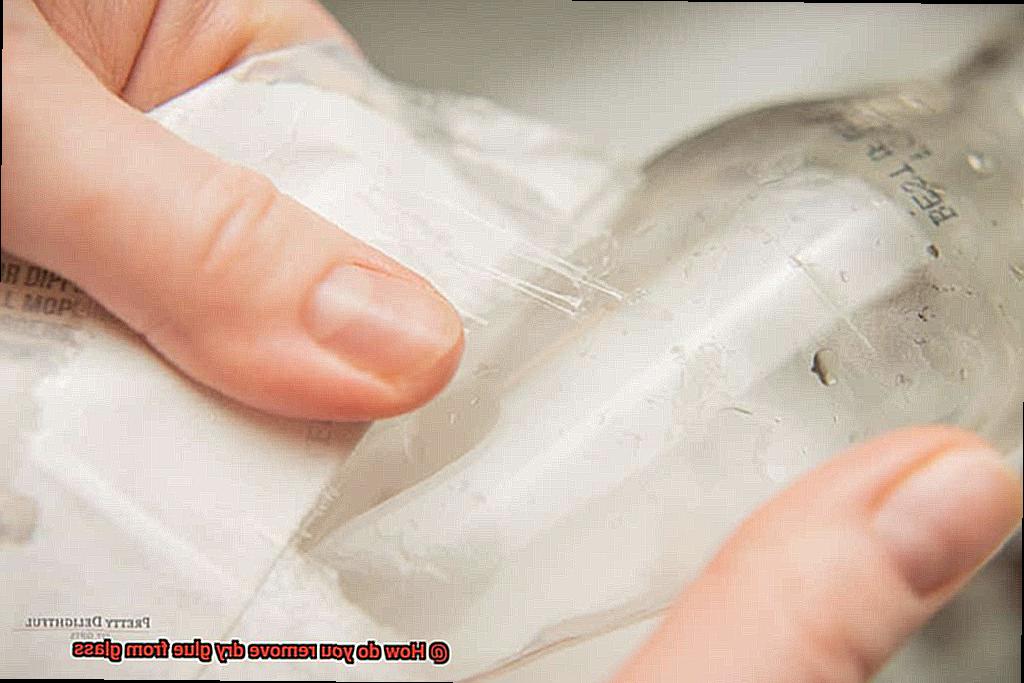
When handling rubbing alcohol or acetone, ensure you’re working in a well-ventilated area to prevent inhalation of fumes. Additionally, safeguard your skin by wearing protective gloves. Regardless of how harmless they may seem, prioritizing safety when dealing with chemicals is of utmost importance.
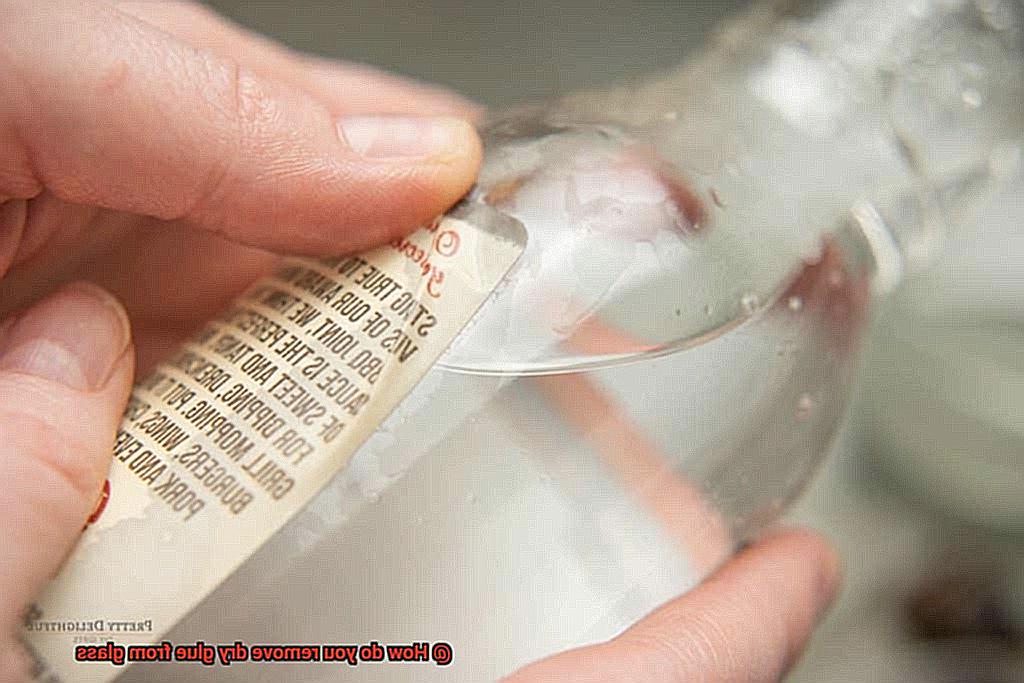
Test the Waters: A Prudent Approach
Before embarking on a full-scale assault on your glass surface, it’s wise to conduct a preliminary test using these solvents on a small, inconspicuous area. This allows you to assess potential damage or discoloration that may arise. Remember, it’s better to be safe than sorry.
Method 3: Utilizing vinegar or lemon juice’s acidic properties to break down the glue.
Sticky mishaps can turn into moments of frustration and annoyance when dealing with stubborn glues on glass surfaces. But fret not. In this article, we delve into the enchanting world of vinegar and lemon juice to uncover their acidic superpowers, making them the ultimate saviors in the battle against glue.
The Science Behind It:
Vinegar and lemon juice, those trusty household staples, boast remarkable acidic properties that work wonders when it comes to breaking down various substances, including glue. The acidity weakens the adhesive bond, providing the perfect opportunity to liberate your glass surfaces from their sticky grip.
The Step-by-Step Guide:
- Prepare for glory: gather a cloth or sponge, vinegar or lemon juice, and warm water.
- Immerse the cloth or sponge in vinegar or lemon juice until it soaks up their acidic might.
- Brave the battlefield armed with your soaked cloth or sponge and confront the dried glue on the glass surface head-on.
- Allow the vinegar or lemon juice to sit on the glue for a few minutes, letting it penetrate and dismantle the adhesive’s stronghold.
- Engage in a gentle yet fierce scrubbing duel using circular motions and light pressure with your cloth or sponge. This will loosen the glue from its entrapment on the glass surface.
For those resilient glues that refuse to yield, employ a plastic scraper or an old credit card as your trusty sidekick. Carefully scrape away any remnants of resistance, being mindful not to mar the glass’s pristine beauty.
Rinse away any traces of vinegar or lemon juice residue by lavishing warm water upon your victorious glass surface.
Finally, dry your glass triumphantly with a clean cloth, ensuring no water spots dare tarnish your glorious moment.
The Caveats:
Remember, not all glue types or glass surfaces will succumb to the acidic charm of vinegar or lemon juice. Before employing these methods, embark on a small and inconspicuous test to ensure they don’t unleash unintended havoc upon your glass. And if the glue proves particularly unyielding or these methods fall short, consider seeking out specialized adhesive removers or professional assistance to claim victory.
Method 4: Applying heat with a hairdryer or heat gun to soften and scrape off the glue.
Are you locked in a battle with a stubborn, clingy glue on your beautiful glass surface? Fear not. Method 4 is here to swoop in like a superhero and save the day. Picture this: the power of heat from a hairdryer or heat gun, melting away that pesky adhesive, leaving your glass surface gleaming and free from the clutches of glue.
But how does this method work its magic? It’s all about harnessing the transformative power of heat. The gentle warmth from the hairdryer or heat gun breaks down the adhesive properties of the glue, weakening its grip on your glass. It’s like giving the glue a warm embrace and convincing it to let go, releasing its hold on your precious surface. And don’t worry – if done correctly, this technique won’t harm your glass in the process.
To embark on this adhesive-removing adventure, you’ll need a few trusty tools by your side: a hairdryer or heat gun, a scraper or putty knife, and some protective gloves. Safety first, my friends.
Let’s dive into the action. Plug in your hairdryer or heat gun and set it to a medium heat setting. Give it a moment to warm up and then hold it about 6-8 inches away from the glued area. We want to avoid overheating or damaging our precious glass, after all.
Now, it’s time to unleash the power of heat upon that stubborn glue. Direct the warmth towards the glue, moving the hairdryer or heat gun back and forth to distribute the heat evenly. As you do this, you’ll witness a mesmerizing transformation – the glue starting to soften and surrender its hold. It’s like watching a superhero movie where the villain’s powers slowly crumble under pressure.
Once the glue has been sufficiently softened, grab your trusty scraper or putty knife and gently begin scraping off the glue. Remember, be gentle and avoid applying too much pressure that could scratch or damage the glass. We’re aiming for a smooth finish, after all.
But what if the glue hardens again during the scraping process? Don’t panic. That’s just a minor setback. Simply reapply some heat from your hairdryer or heat gun and continue scraping until every last bit of glue is vanquished. It’s like giving that stubborn villain another dose of defeat – they won’t stand a chance against your determination.
Congratulations, you’ve successfully scraped off all the glue, freeing your glass from its sticky prison. But wait, there’s one more step to complete this heroic mission – give your glass a well-deserved cleaning. Reach for a trusty glass cleaner or mix warm water with mild dish soap to wipe away any residue left behind. Your glass will thank you for its newfound freedom.
Method 5: Commercial adhesive removers designed specifically for glass surfaces.
From stubborn stickers to DIY disasters, glue residue on glass surfaces can be a real eyesore. But fear not. We have the secret weapon in our arsenal: commercial adhesive removers designed specifically for glass surfaces. In this comprehensive guide, we will walk you through the step-by-step process of effectively using these products to banish glue residue and restore your glass to its former glory.
Step 1: Choose the Perfect Adhesive Remover:
Before diving into action, it’s crucial to select the right adhesive remover for your glass surface. Look for products explicitly labeled for use on glass, available in liquid or gel form. You can find these miracle workers at hardware stores, home improvement centers, or online retailers.
Step 2: Test, Test, Test:
Your glass surfaces are precious, so before unleashing the adhesive remover’s power, take a moment to test it on a small, inconspicuous area. This ensures that the product won’t cause any damage or discoloration on your prized glass surface.
Step 3: Apply and Wait:
Now that you’ve found the perfect adhesive remover and tested its compatibility, it’s time to get down to business. Apply a small amount of the product onto a clean cloth or sponge, gently rubbing the affected area. Remember, even pressure is key here – no need to go all Hulk on your glass. Allow the adhesive remover to work its magic for a few minutes as recommended by the manufacturer.
Step 4: Wipe Away the Residue:
Once the waiting time is up, grab another clean cloth or sponge and wipe away the softened glue residue. Prepare to be amazed at how effortlessly it comes off. If stubborn remnants persist, repeat the process until your glass surface is squeaky clean.
Step 5: The Final Touch:
Congratulations. You’ve successfully banished the glue residue from your glass surface. But before you call it a day, give your glass a final touch-up by thoroughly cleaning it with a glass cleaner. This ensures that no adhesive remover residue remains, leaving your glass looking flawlessly clear and shiny.
Precautions: Tips on how to be cautious when removing dry glue from glass to prevent damage.
Removing dry glue from glass requires careful handling to prevent damage to the glass surface. By following precautions and tips, you can safely remove the glue without causing harm. This article provides valuable information on how to be cautious during the removal process.
Gather the Right Tools:
Before starting, gather necessary tools like a plastic scraper or putty knife, rubbing alcohol or acetone, cotton swabs or soft cloths, and mild dishwashing detergent. Using the right tools ensures effective and safe glue removal without damaging the glass.
Test a Small Area:
Test a small, inconspicuous area of the glass before applying any solvent or cleaner to the entire glue-covered area. This helps determine the glass’s reaction to the solvent and if it causes damage or discoloration. If there are no adverse effects, proceed with caution.
Protect Surrounding Surfaces:
Cover adjacent areas with masking tape or plastic wrap to protect sensitive surfaces from accidental spills or scratches during glue removal.
Work in a Well-Ventilated Area:
Some solvents or cleaners emit strong fumes that can be harmful if inhaled in large quantities. Work in a well-ventilated area with open windows for proper air circulation. Wear a mask or respirator if necessary to protect yourself from potentially harmful vapors.
Avoid Excessive Force:
To prevent scratches or cracks, avoid applying excessive force or pressure when removing dry glue from glass. Gently scrape or rub the glue with the chosen tool, being cautious not to damage the glass.
Take Breaks:
When dealing with a large area of dry glue or if the removal process is taking longer than expected, take breaks to prevent fatigue-induced accidental damage. Rest and regain focus before continuing with the removal process.
Clean and Dry Thoroughly:
After successfully removing the glue, clean the glass surface thoroughly. Use a mild dishwashing detergent mixed with warm water to remove any residue or remaining traces of the solvent or cleaner. Rinse the glass with clean water and dry it completely using a soft cloth or paper towels. This prevents streaks or spots and restores glass clarity.
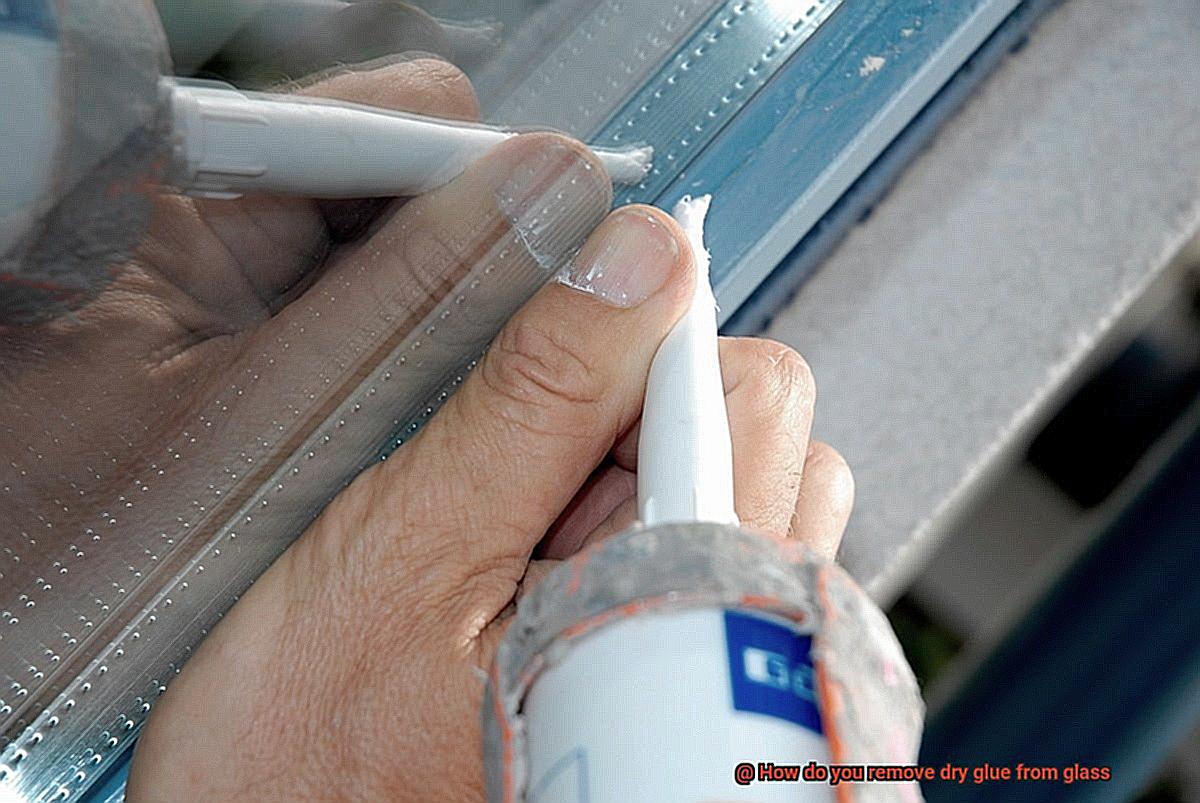
Troubleshooting: What to do if none of the methods work or if there are stubborn residue spots left behind.
Removing stubborn glue residue from glass can be a frustrating task. However, if none of the previous methods have worked or if stubborn residue spots are still present, there are alternative techniques and tips that you can try. In this article, we will explore these methods to help you effectively remove those pesky glue spots from glass surfaces.
Persistence Pays Off:
When dealing with stubborn glue residue, it’s important to stay determined and keep trying different methods. Don’t give up easily. Sometimes, it takes a little extra effort to achieve the desired results. So, roll up your sleeves and approach the problem with persistence and a positive mindset.
Heat Application:
Heat can be a powerful ally in fighting stubborn glue spots. Grab a hairdryer and set it on its highest setting. Direct the hot air onto the affected area and watch as the glue softens before your eyes. But be cautious not to overheat the glass, as it may crack. Once the glue is softened, gently scrape it off with a plastic scraper or even a credit card.
Solvent-Based Removers:
If other methods fail, it’s time to bring out the big guns – solvent-based removers. Acetone or nail polish remover containing acetone can work wonders in breaking down stubborn glue residue. Take a cotton ball or cloth, apply a small amount of acetone, and gently rub it onto the residue spot. Just make sure to work in a well-ventilated area and wear gloves for your safety.
Natural Alternatives:
If you prefer a more natural approach, consider using household items like vinegar or rubbing alcohol. Both substances have adhesive-dissolving properties and can sometimes help loosen stubborn glue residues. Soak a cloth or sponge in vinegar or rubbing alcohol and gently rub the affected area in circular motions. Allow the liquid to penetrate the glue for a few minutes before attempting to remove it with a scraper or your fingernail.
Seek Professional Assistance:
If none of the above methods work or if you’re dealing with valuable or delicate glass items, it might be best to seek professional help. Glass restoration specialists or professional cleaners have the knowledge and tools to handle stubborn glue residue without causing damage. They can provide you with specialized solutions and techniques tailored to your specific situation.
Prevention: Suggestions on how to prevent future instances of dry glue on glass surfaces.
Dealing with dry glue on glass surfaces can be exasperating and time-consuming. But fear not. With a few simple preventive measures, you can say goodbye to those stubborn adhesive residues. In this article, we will explore effective strategies for preventing future instances of dry glue on glass surfaces. So, let’s dive in.
Store Glue Properly:
Ensure that the cap or lid of your glue container is tightly sealed after each use. This prevents air from entering and drying out the glue, preserving its adhesive properties. Furthermore, store your glue in a cool, dry place to extend its shelf life.
Use Glue Conservatively:
Avoid excessive amounts of glue as it not only wastes the adhesive but also increases the chances of it drying out and leaving residue on the glass surface. Apply just enough glue to create a strong bond, avoiding any excess that could become difficult to remove.
Clean Glass Surface Before Applying Glue:
A pristine glass surface is vital for optimal adhesion. Dirt, dust, or oils can hinder the effectiveness of the glue. Hence, before applying any adhesive, clean the glass surface with a mild detergent or glass cleaner, ensuring it is thoroughly dried.
Utilize Protective Measures:
When working on projects involving multiple objects glued together, take precautions by using masking tape or plastic sheets. Masking tape applied around the edges of glass surfaces catches excess glue, preventing it from coming into contact with the glass itself. Plastic sheets or covers protect surrounding areas from spills or drips, minimizing the chances of dry glue forming on the glass.
Clean Spills and Excess Glue Immediately:
Accidents happen, but leaving spilled or excess glue to dry on the glass surface only makes it harder to remove later on. Act swiftly by using a damp cloth or sponge to wipe away any spills or excess glue as soon as possible. This prevents the glue from drying out and forming stubborn residue on the glass.
i7gb0BQZmVA” >
Also Read: How to Remove Glue From Mirror?
Conclusion
Removing dry glue from glass can be a frustrating task, but fear not, for there are effective methods to conquer this sticky situation.
One technique involves using a simple household ingredient: vinegar. Soak a cloth in vinegar and gently rub the glue until it starts to dissolve.
Another option is to apply heat to the glue using a hairdryer or heat gun. The heat will soften the glue, making it easier to scrape off with a plastic scraper or your fingernail.
For stubborn residue, try using rubbing alcohol or nail polish remover. These solvents work wonders in breaking down the adhesive properties of the glue.
Remember to always test these solutions on a small, inconspicuous area of the glass before applying them to larger surfaces.

